2025 Solar Ultrasonic Deer & Garden Pest Deterrent, 2-Pack, Waterproof, Motion-Activated
$37.99
Stop night raids without traps or chemicals. This 2025 Solar Ultrasonic Animal Repeller, 2-Pack uses a PIR motion sensor to trigger high-frequency sound and quick flashes that persuade deer, cats, raccoons, skunks, squirrels, and rabbits to move along. The units are solar powered with USB backup and built for outdoor use with weather-resistant housings. Independent research on garden cats shows ultrasonic deterrents can reduce visits and time spent in yards, especially when devices are placed on entry routes and left in position for a few weeks. That is the calm, humane edge most gardens need.
Description
If night raids from deer, cats, raccoons, or squirrels are turning your garden into a buffet, the 2025 Solar Ultrasonic Deer & Garden Pest Deterrent, 2-Pack, Waterproof, Motion-Activated gives you an easy, humane way to push wildlife back to the hedgerows without traps or chemicals. These units combine a wide-angle PIR motion sensor with pulsed ultrasonic output and a strobe to startle intruders, powered by the sun so you can set and forget. Similar outdoor ultrasonic deterrents report effective detection ranges around 10 meters and wide sensor angles on retail listings, which is the practical yardstick for planning coverage in a medium garden.
I’ll be real with you. Ultrasonic control isn’t magic, lab and field results are mixed because animals, environments, and device quality vary. There is peer-reviewed evidence that ultrasonic deterrents can cut garden incursions by neighborhood cats roughly in half, and reputable commercial units publish frequency bands in the tens of kilohertz for small mammals. The takeaway is simple. Used thoughtfully, placed well, and combined with good garden hygiene, an ultrasonic repeller can be the nudge that keeps curious visitors at the fence line.
Key Customer Benefits
- Humane, no-poison protection that fits real gardens: The solar ultrasonic animal repeller uses sound, light, and motion to scare animals without traps or chemicals. Extension services consistently recommend humane deterrents and garden hygiene before lethal control, and they note that a combined approach reduces damage best in home landscapes.
- Proven help with roaming cats around beds and feeders: Peer-reviewed field trials found that an ultrasonic cat deterrent cut garden incursions by about forty to fifty percent, and reduced the time cats spent in yards by more than seventy percent. That means fewer toilet patches in seedbeds and less stalking under bird feeders when the device is placed correctly. The Royal Society for the Protection of Birds also endorses a sensor-triggered ultrasonic cat scarer for garden use.
- Motion activated response that startles, then teaches avoidance: Passive infrared, or PIR, sensors react to warm-bodied movement and are widely used in outdoor security and wildlife systems. Sudden light or sound on detection is a classic fright tactic that can interrupt feeding or probing behavior, especially when animals are new to the area. Research summaries on “frightening devices” and motion deterrents support their role as part of an integrated plan.
- Better first line of defense against deer browsing: Deer can strip new growth in days and rub bark off young trees, which is why extensions warn that home landscapes can become primary food sources. While permanent fencing is the gold standard, motion deterrents can reduce damage pressure and protect high-value spots where fencing is impractical. Use the repeller to cover choke points and pair it with plant selection and physical barriers on the most vulnerable specimens.
- Helpful on raccoon and skunk patrols when you remove attractants: Humane guidance emphasizes cleaning up pet food, fallen fruit, and unsecured trash, then layering motion triggers like lights, sound, or sprinklers. This repeller gives you that instant surprise cue. Expect best results when you also remove food rewards that keep raccoons and skunks coming back.
- Solar power and set-and-forget convenience for busy weeks: Because it is solar powered and motion activated, you are not running cords or remembering to switch it on each night. That matters in real life when garden chores pile up, and it is consistent with research and field projects that favor low-cost, low-maintenance deterrent layers on farms and yards.
- Honest expectations, fewer surprises: Independent tests show ultrasonic devices are not perfect for every species or setting. Some studies on deer found no measurable benefit from certain models, and all wildlife can habituate if the environment still offers easy calories. You will get the most value when you combine this motion activated deer repellent with deer-resistant plant choices, taste or odor repellents on favorite plants, and basic exclusion where needed.
Product Description
What this repeller is
This 2025 solar ultrasonic animal repeller, 2-pack is a humane garden guardian that listens and responds. Each unit sits quietly at the edge of your beds. When the sensor notices warm-bodied movement, it fires a short burst of high-frequency sound and a quick flash to startle intruders, then goes back to standby.
There are no cords to run across the lawn because the built-in panel tops up the battery in daylight. Motion-triggered wildlife deterrents and other “fright” devices are a recognized layer in home and landscape protection, especially when you combine them with good garden hygiene and selective plant choices.
How it works, under the hood
Inside the housing is a PIR motion sensor that watches for changes in infrared energy. Warm animals moving against a cooler background trip the sensor, which cues the unit to emit sound that most people cannot hear but many animals find unpleasant. PIR technology is the same idea used in outdoor security lights and trail cameras. It is tuned to pick up movement from living creatures rather than leaves in the wind, and the sensitivity can be adjusted to fit your yard.
When you are targeting roaming cats, there is real-world evidence that ultrasonic deterrents can help. Independent trials in suburban gardens reported that ultrasonic devices reduced the number of cat incursions by about forty to fifty percent and cut the time cats spent in yards by roughly seventy to eighty percent. That does not eliminate every visit, although it meaningfully lowers pressure around beds and bird feeders.
For deer, no single trick works every time. University extensions are clear that fencing is the only sure long-term solution, while repellents and motion deterrents reduce damage in many situations. Use this repeller to cover choke points, then protect especially tasty plants with wraps, netting, or a spritz of taste-based repellents based on your local guidance.
What makes it effective and different when used well
Where many gadgets run constantly, this unit is motion activated, which matters for two reasons. First, it saves power so the solar charge keeps up in normal weather. Second, it creates a short, surprising cue. That surprise is the entire point of a fright device. It interrupts browsing or prowling long enough for the animal to decide your garden is not worth the risk and move along. Field guidance on “scare” tools and extension bulletins both place motion-triggered sound and light in the tool-kit for deterring wildlife around homes.
It is also humane. You are not trapping, poisoning, or injuring animals. Reputable wildlife and gardening organizations endorse ultrasonic or motion-triggered scarers for specific problems such as cats under bird feeders, with the important note that you must place the device thoughtfully and give it a few weeks to change patterns. That expectation setting is realistic and aligns with how these tools were tested.
Product Specifications
| Feature | Typical Value for This Category |
|---|---|
| Power | Solar charging with USB backup, 5 V input |
| Battery | Rechargeable Ni-MH pack around 600 to 800 mAh per head |
| Waterproof rating | IP44 to IP66 depending on brand |
| Detection method | PIR motion sensor |
| Sensor coverage | About 110 to 120 degrees horizontally |
| Detection distance | About 8 to 10 meters, which is about 26 to 33 feet |
| Effective deterrent area | Cone of sound in front of each head; up to about 10 meters for premium units |
| Ultrasonic frequency | Adjustable bands commonly spanning about 15 to 45 kilohertz, sometimes wider to about 60 kilohertz |
| Sound pressure | About 90 decibels at 1 meter for pro units |
| Light deterrent | Flashing LEDs that pulse briefly on trigger |
| Housing and stake | UV-resistant ABS plastic with ground stake or wall mount option |
| Dimensions | Vary by brand; handheld head units are often about 15 to 20 cm tall not counting the stake |
| Operating modes | Motion-activated by default; some models provide continuous or sensitivity levels |
| Compliance and certifications | CE marked is common on branded units; some note EPA establishment numbers |
How to Use and Install It
Step 1. Walk your yard and plan coverage
Before you unbox anything, take five minutes to see how animals actually enter. Look for narrow gaps in hedges, low spots under fences, worn trails, bird-feeder fallout, compost corners, and veggie beds that get hit first. Those are your “choke points.”
Ultrasonic repellers work in a forward cone, not a perfect bubble, so aim each head down the approach path rather than straight up or randomly across the lawn. Pro manuals and product pages for outdoor ultrasonic units describe directional coverage out to roughly ten meters in front of the device, which is enough to guard typical gate gaps, bed edges, and bird-feeder zones.
Step 2. Set height and angle for the animal you want to deter
Mount or stake each unit so the speaker points at chest-to-head height of the target animal. That usually means ankle-to-knee height for cats and skunks near beds, and about hip height for deer along a path. Keep the face level and pointed into the approach, not across open space.
Wildlife and garden organizations that endorse motion-triggered ultrasonic scarers for cats note that placement is the difference between “it helped” and “I barely noticed.” They also set expectations that some cats need a few weeks to change their routine, which is normal behavior shaping.
Step 3. Avoid false triggers when you aim the sensor
The built-in PIR sensor “sees” changes in infrared energy from warm bodies moving across the field of view. To keep it focused on animals, avoid pointing directly at heat sources or areas that get shimmering heat or moving hot air. Do not face a sensor straight at reflective windows or vents, and keep it clear of branches that wave close to the lens. Security and alarm installers give the same advice for PIRs because sunlight, HVAC exhaust, and nearby movement can trip low-quality sensors.
Step 4. Give the solar panel the best shot at charging
For fixed devices in the northern hemisphere, aim the panel toward true south and tilt it roughly in the range that matches your latitude so it sees sun for longer hours. This simple rule of thumb is the same one used by the U.S. Energy Information Administration and EnergySaver guidance for small solar systems. If you are in heavy shade, consider relocating the unit or topping up through the USB backup before a busy wildlife week.
Step 5. Choose a starting mode and tune gently
Begin in motion-activated mode with medium sensitivity. Set frequency to the band intended for your target species and make small tweaks over several evenings. Manufacturer manuals for established units explain that some people may hear brief “chirps” as the device turns on and off, and that slightly changing the dial can stop any audible squeak while keeping output in the right range. If you work near bird feeders, angle the head a touch downward to catch low stalking routes that cats prefer.
Step 6. Layer with simple hygiene so animals do not have a reason to return
Deterrents do their best work when you also remove easy calories. Lock down trash, clean fallen fruit, feed pets indoors, and store kibble and seed in sealed bins. Humane wildlife organizations stress that most “raccoon problems” are unsecured food and access problems, and they support using motion-triggered cues as part of a humane plan that moves animals along without harming them.
Step 7. Give it two to four weeks and move units a little if needed
Behavior change takes repetition. The RSPB’s guidance for an approved ultrasonic cat scarer notes that some cats test boundaries for up to four weeks before the area “feels” not worth it. If visits continue from the same direction, nudge the device a meter or two or change the angle so the animal encounters the surprise cue a little earlier. Small relocations can break early habituation.
Step 8. Weatherproofing and safety checks
Outdoor models often carry IP ratings like IP44 or higher, which indicate resistance to splashing water and small particles. Keep the speaker grill upright, do not submerge, and wipe off mud or snow so the sensor can “see.” If your unit includes USB charging, keep the port cap sealed. The IEC explains how IP codes are graded, and industry summaries clarify that IP44 is common for garden lighting and similar enclosures.
Step 9. Pets, people, and hearing ranges
These devices aim at frequencies most adults cannot hear, although some people notice switching clicks or a faint tone at certain settings. Cats and dogs hear much higher pitches than we do, which is why the sound is aversive for them even when it is silent to us. Peer-reviewed and veterinary sources place feline hearing up to roughly 64 to 85 kilohertz, far above the human upper limit around 20 kilohertz. If anyone in the home reports discomfort, change the frequency slightly or reposition the unit.
Step 10. A quick maintenance routine
Once a week in the growing season, give the lens and panel a wipe, confirm the stake is firm after rain, and check that LEDs flash when you walk through the detection zone at dusk. If nights are long and cloudy, top up the battery with USB and return to solar the next day. Established manuals for motion-activated ultrasonic repellers recommend exactly this kind of simple check so you catch low charge or misalignment before a new browsing wave hits.
University extension notes on deer control report that motion-activated devices can help for a period, particularly when aimed at paths and paired with other tactics. If you are protecting very high-value plants, add physical wraps or a taste-based repellent to those spots while the ultrasonic units handle general traffic.
Frequently Asked Questions
Do ultrasonic animal repellers actually work on cats in gardens?
Yes, with realistic expectations. A peer-reviewed field study tracking real backyard visits found that ultrasonic devices cut cat incursions by about forty to fifty percent and reduced the time cats spent in yards by roughly seventy to eighty percent. That lines up with the Royal Society for the Protection of Birds’ endorsement of a motion-triggered ultrasonic scarer that it tested over multiple seasons, noting some cats take up to four weeks to change habits.
Will an ultrasonic unit keep deer off my shrubs?
Results are mixed. Multiple university extensions say motion-based “fright” tools can reduce browsing in some situations, especially when pressure is light and units are aimed at travel paths. The same sources caution that deer quickly habituate and that fencing remains the only near-sure solution for high-value plants. Consider pairing an ultrasonic device with motion sprinklers or taste-based repellents on favorite plants.
Are motion sprinklers better than sound for deer?
They are often very effective because the sudden water burst provides a strong surprise cue. Extension guides recommend motion sprinklers as a humane, practical option for gardens, and recent roundups of user reviews point to consistent success on deer when units are positioned well.
Will this bother my own dog or my neighbor’s dog?
Dogs hear higher pitches than adult humans, so some dogs will notice and dislike certain frequency settings. Community threads and homeowner forums confirm that pet sensitivity varies. If you have dogs nearby, angle the device to cover only the problem zone and try a slightly different frequency band or lower sensitivity. A quick neighbor chat helps too if a pet seems bothered.
Can people hear ultrasonic repellers?
Most adults cannot hear steady tones above about 17 to 20 kilohertz, although a few will notice switching clicks or a faint whistle as the unit turns on. Reports from neighborhood forums show that some individuals are sensitive to certain models or settings. If anyone finds it irritating, nudge the frequency dial, shift the angle, or move the unit a meter or two to reduce direct exposure.
Do these devices affect wildlife like hedgehogs or birds?
Guidance around an RSPB-endorsed cat scarer indicates the unit targets feline hearing and routine garden birds are not the goal of the sound field. Still, best practice is to aim only at the problem approach path and avoid pointing directly at feeders or nest boxes. If you host hedgehogs, keep the beam off their feeding lane and monitor behavior after installation.
How should I place it so it triggers on animals and not on wind or sun glare?
Treat the sensor like a small outdoor security device. PIR sensors react to warm-bodied movement across their field of view. Aim along known paths, keep branches out of the near field, and avoid reflective windows, vents, or surfaces that radiate heat. Camera and alarm manufacturers explain that these heat and movement artifacts are common reasons for false triggers.
Will rain damage it? What does IP44 actually mean?
Look for the IP code on the label. IP44 is common for garden gear and means the enclosure resists splashing water from any direction and keeps out larger particles. Keep the speaker grill upright, reseal the USB cap after charging, and wipe away mud so the sensor “sees” clearly.
How far does the motion sensor reach and what area does the sound cover?
Specs vary by brand. A well-documented outdoor unit lists a motion zone roughly 35 feet by 70 feet, a frequency band around 15 to 25 kilohertz, and about 90 decibels at one meter at the source. Sound travels in a cone in front of the device rather than a perfect bubble, so aim down the approach path.
What frequency should I choose for cats, squirrels, or raccoons?
Manufacturers usually provide a dial or presets spanning bands in the tens of kilohertz. Start with the cat or small-mammal setting, watch results for a week, then make small adjustments. Forum users often report that a slight change can stop an audible squeak for humans while keeping the deterrent effective for animals.
Do raccoons and skunks respond to ultrasonic plus light?
They can be startled by a sudden cue, especially when you also remove the reward that keeps them coming back. Humane groups emphasize locking down trash, feeding pets indoors, sealing bins, and then layering motion cues like lights, sprinklers, or sound. The combination changes the cost-benefit for the animal.
What if the device seems to stop working after a few weeks?
Animals can habituate when an easy meal remains. Rotate the angle a little, shift the device, or change the frequency so the cue feels “new.” Then remove attractants and add a second tactic, for example a motion sprinkler at the prime entry gap or a taste-repellent on a few plants. Extensions and user communities both note that small changes restore effectiveness.
Do I need sun for the solar panel all day? How do I charge in winter?
No. The small onboard panel tops up the battery over daylight hours. In long cloudy spells or winter, use the USB backup if your model provides it, then return to solar. This approach mirrors manufacturer guidance for outdoor ultrasonic and security devices with solar assist.
Are there any safety or courtesy tips before I install?
Yes. Confirm the IP rating, keep the speaker and lens clean, and avoid pointing directly into a neighbor’s yard or at paths where pets or toddlers play. If someone nearby reports discomfort, adjust frequency and aim, or relocate slightly. Forum threads show that small adjustments usually resolve concerns.
What do real-world users say on forums?
Experiences vary, which is honest and expected. Many gardeners report clear reductions in cat visits when units are placed on favored routes, although budget models may have limited weather sealing. Others prefer motion sprinklers for stubborn wildlife. A fair summary from forum threads is simple. Ultrasonic can help, especially for cats, and works best as one layer in a tidy, well-planned garden.
Conclusion
If you are tired of finding seedlings clipped and beds prowled at dusk, this 2025 solar ultrasonic animal repeller, 2-pack is a smart, humane first line of defense that fits real life. The evidence is encouraging where it matters most. Independent field research in suburban gardens recorded fewer cat incursions and much shorter visits when an ultrasonic unit was placed correctly, which is exactly the kind of relief backyard bird lovers and veg growers notice day to day.
For deer, extensions are frank that no single tool is perfect. Motion-triggered cues, including sound and light, will help in many gardens for a time, and a layered plan with targeted barriers on the most vulnerable plants is what keeps damage below the frustration line. Fencing remains the gold standard for high-value specimens, so use the repellers to cover approaches and add wraps or repellents where you absolutely cannot afford browsing.
On build quality and day-to-day use, look for clear ingress-protection markings on the label, keep the sensor window clean, and aim the panel toward good sun. An IP code such as IP44 means the enclosure is designed to resist splashing water and the typical weather a garden device sees.
Related products
-
Nature’s MACE 6 lb Pet-Safe Dog Repellent Granules
$38.97 Buy Now -
Solar-Powered Ultrasonic 4-Pack Outdoor Animal Repellers
$72.99 Buy Now -
Eco‑Solar Ultrasonic 3‑in‑1 Animal Repeller for Squirrels, Deer, Raccoons, Cats
$38.98 Buy Now -
ASPECTEK Yard Sentinel Ultrasonic Animal Repeller with Motion Sensor
$33.99 Buy Now
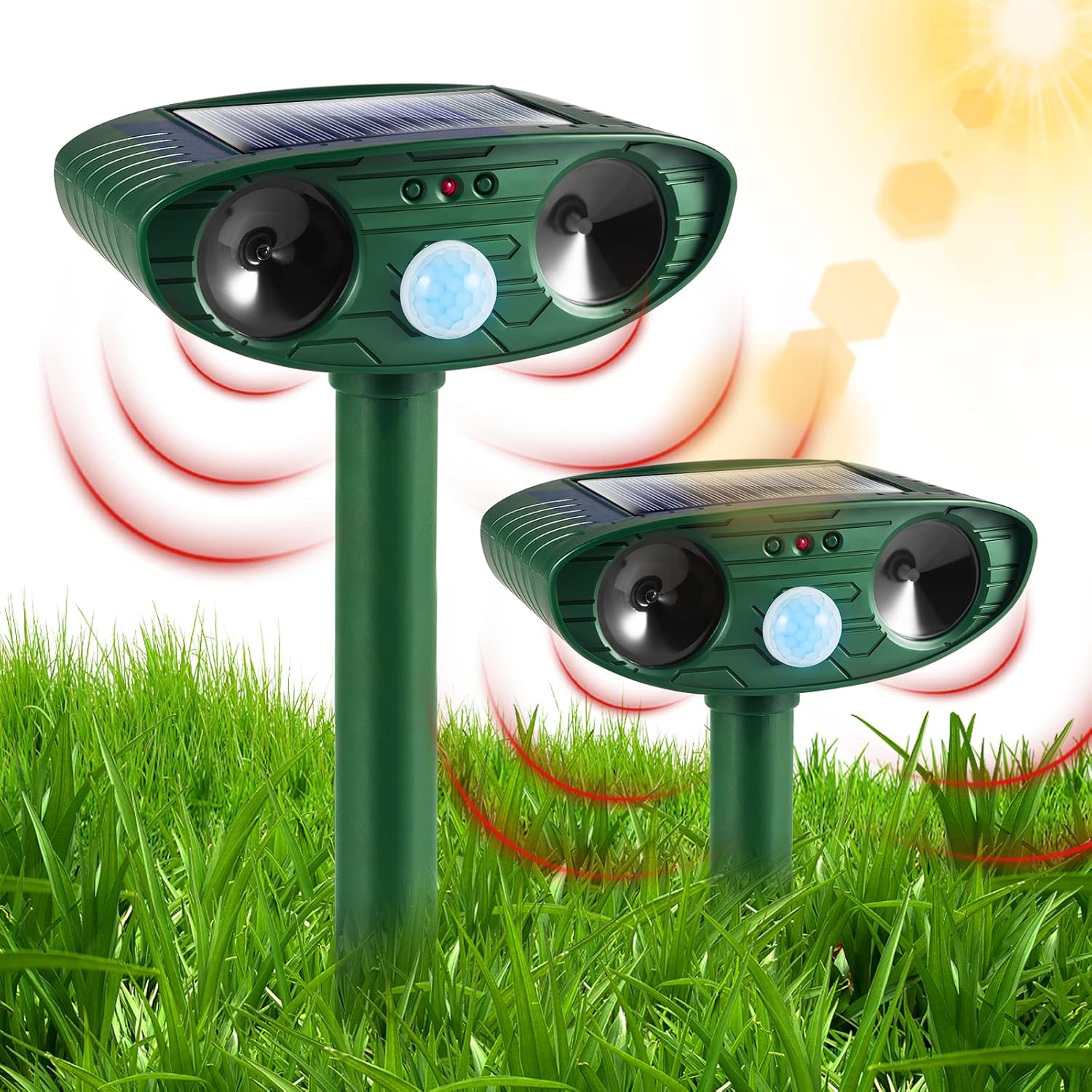
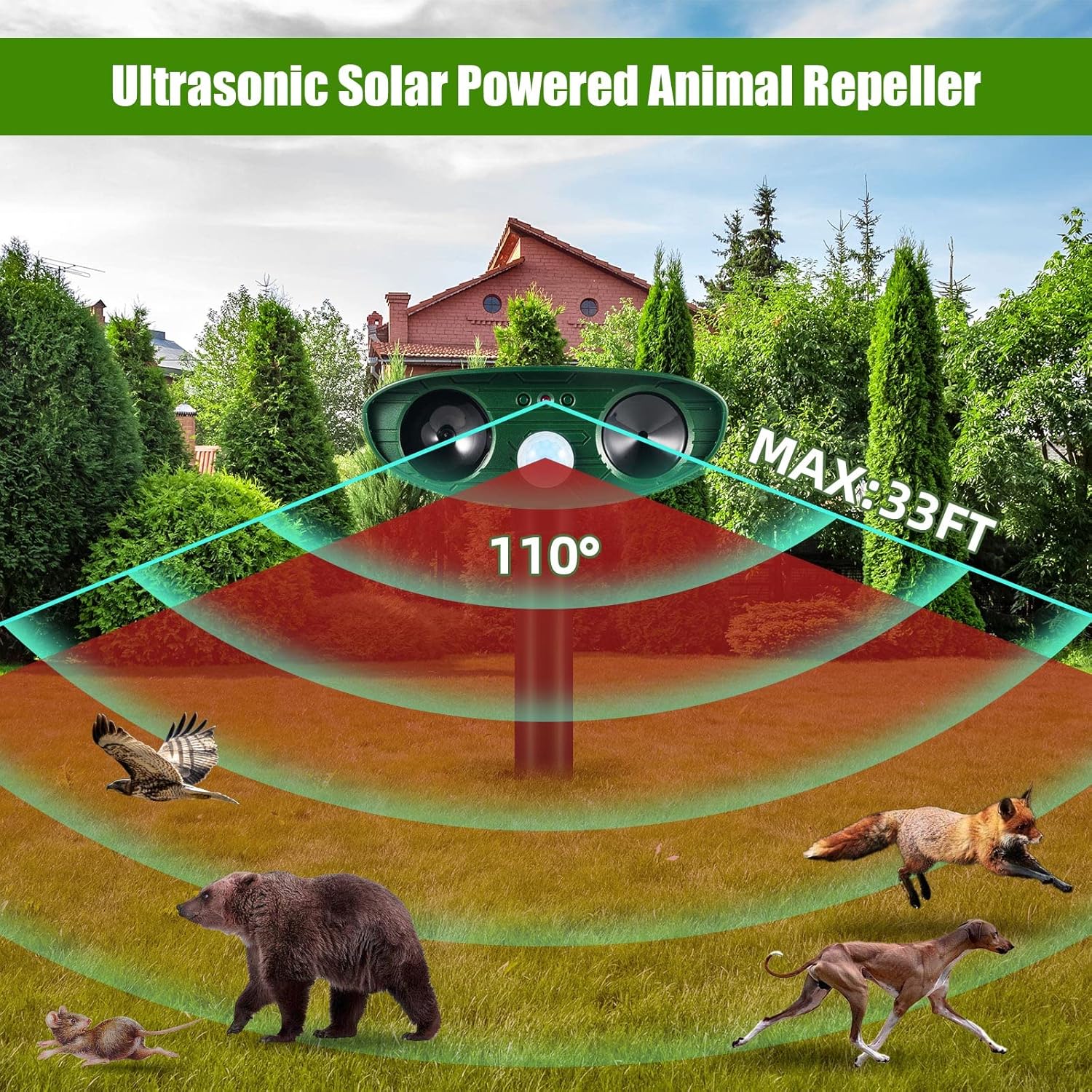
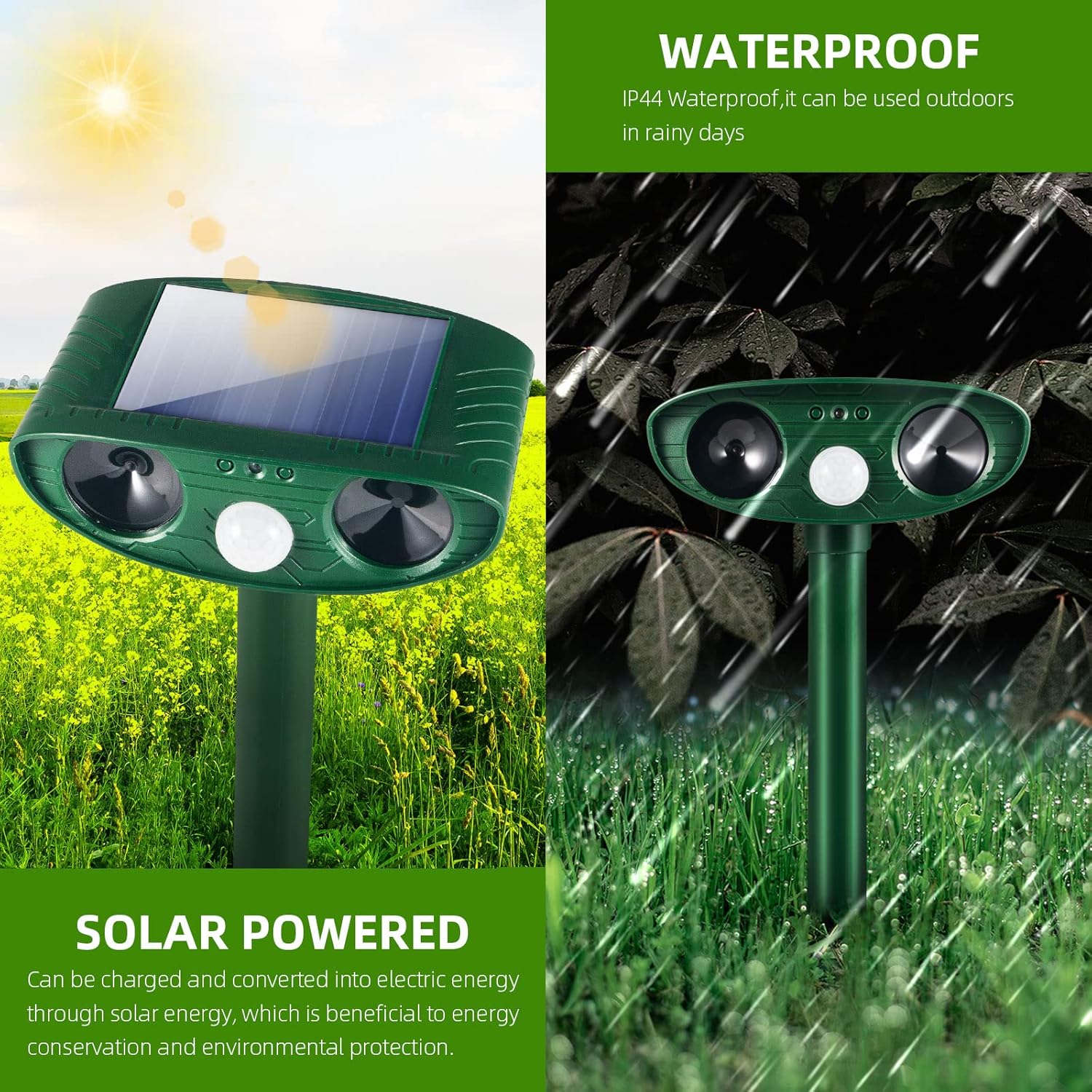
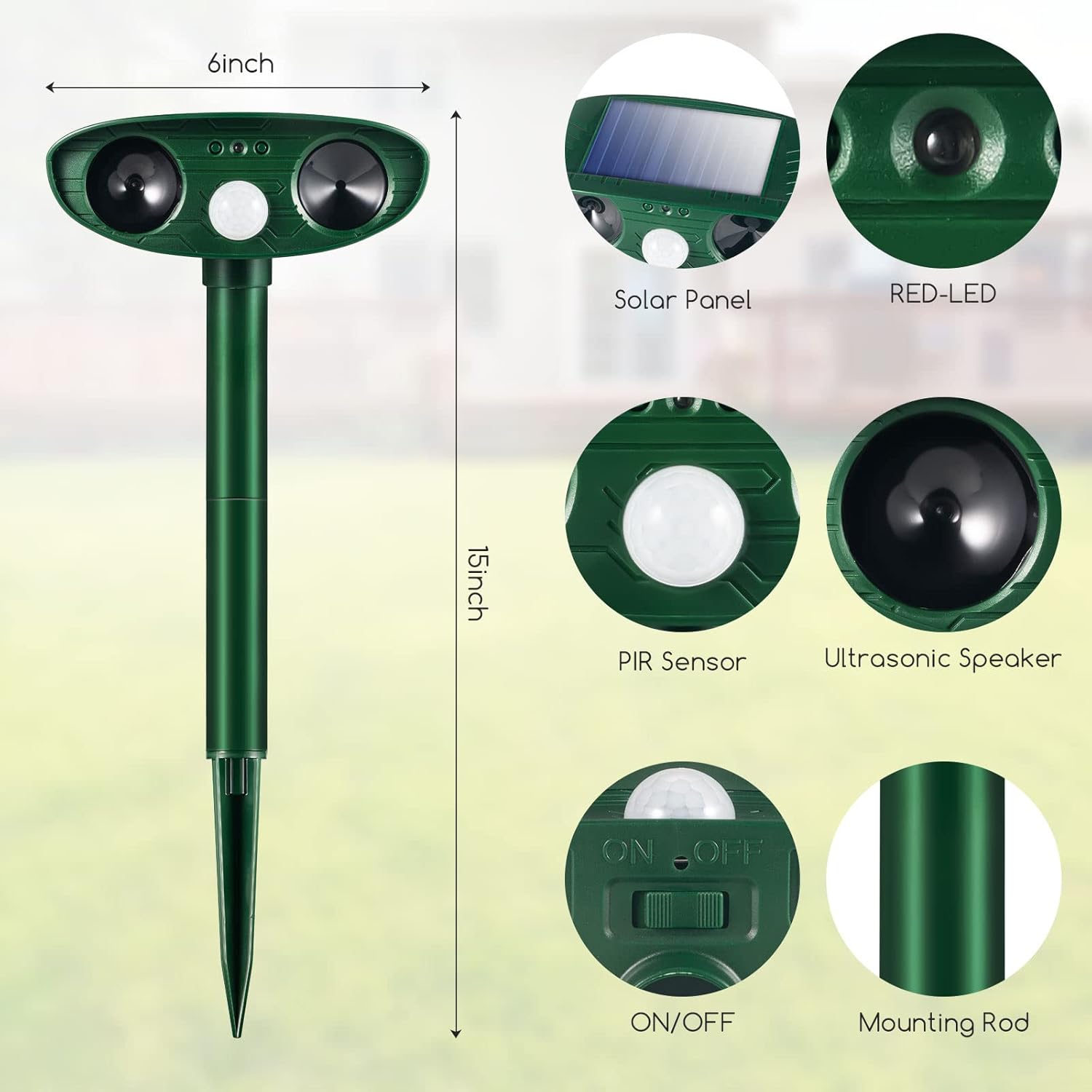
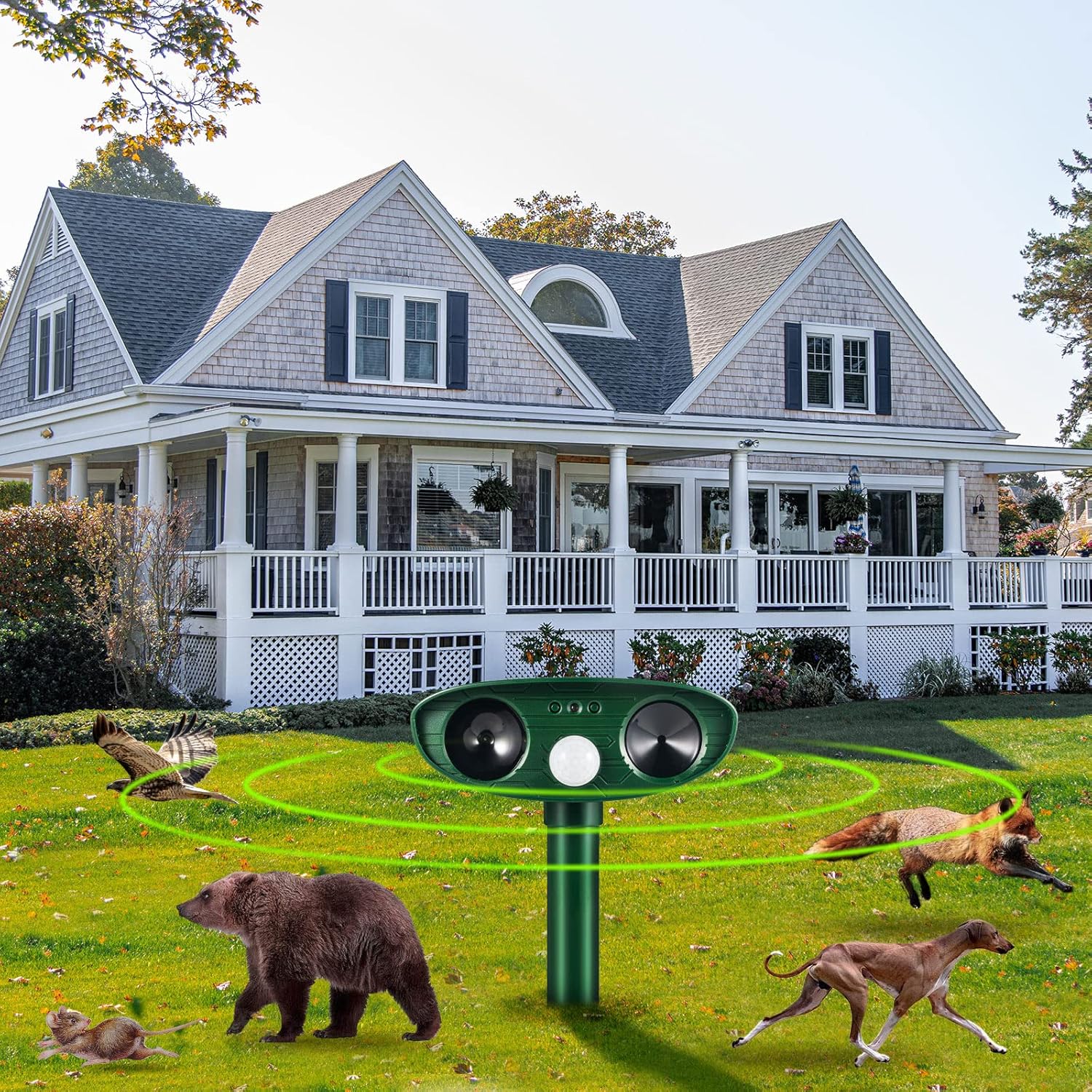
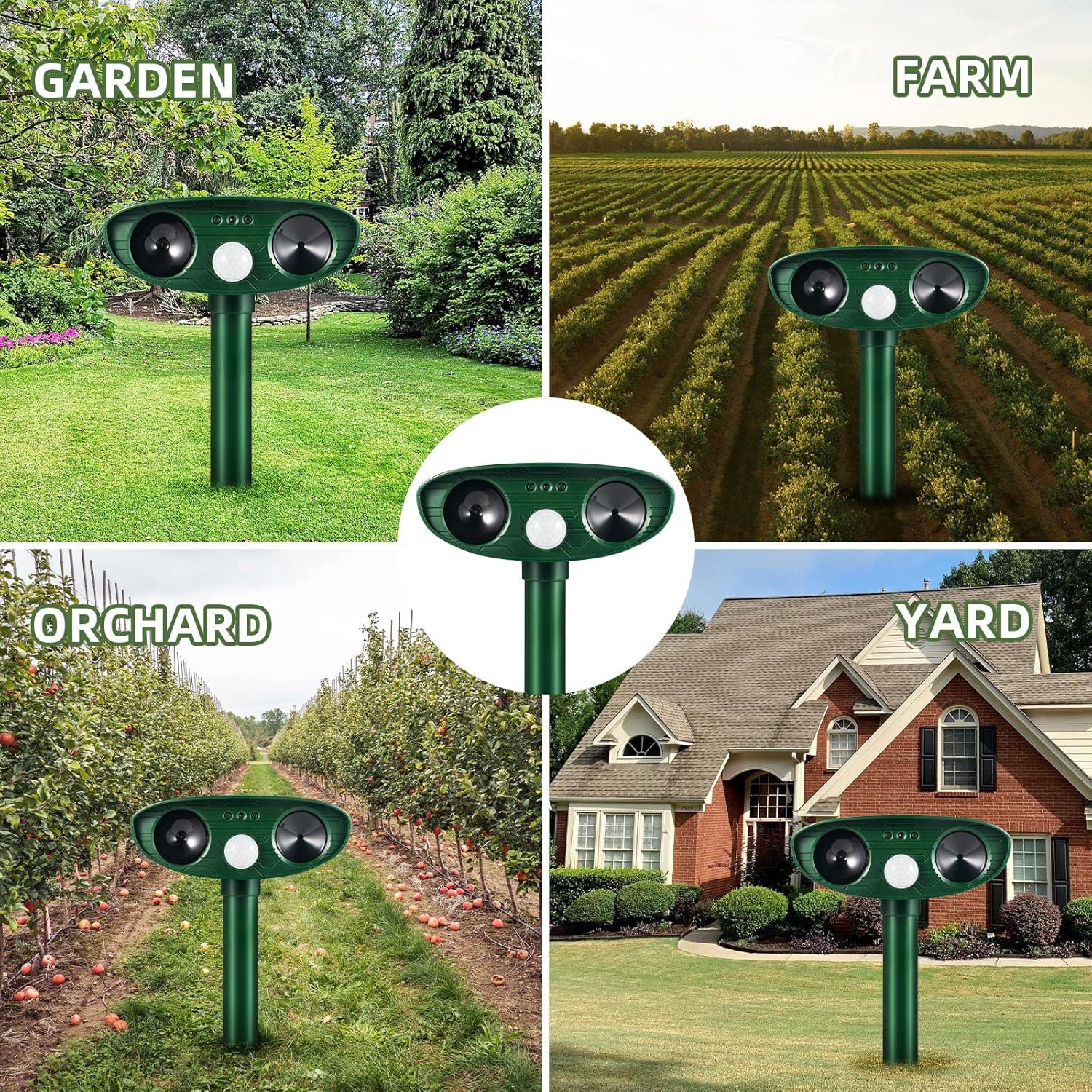
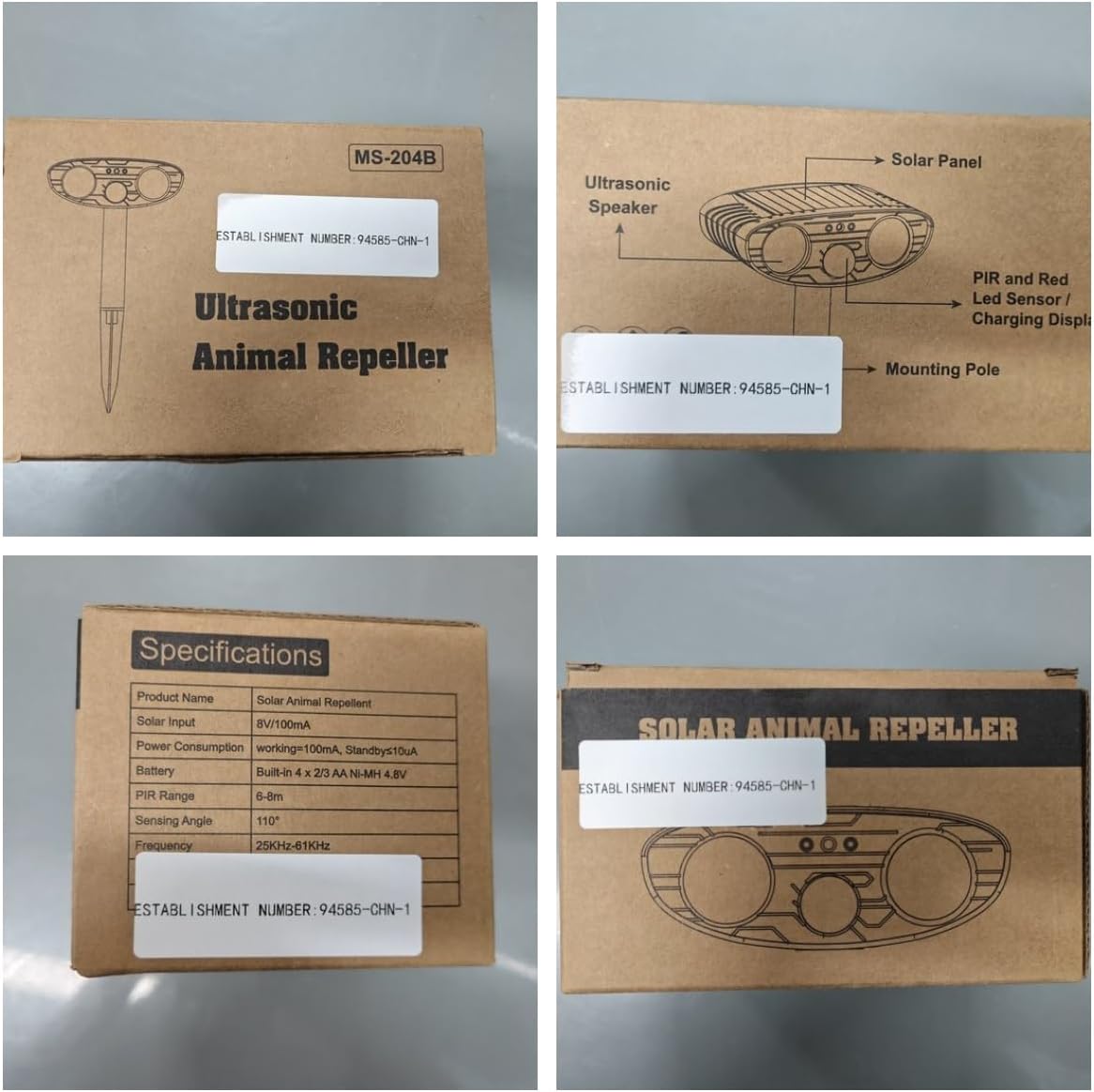
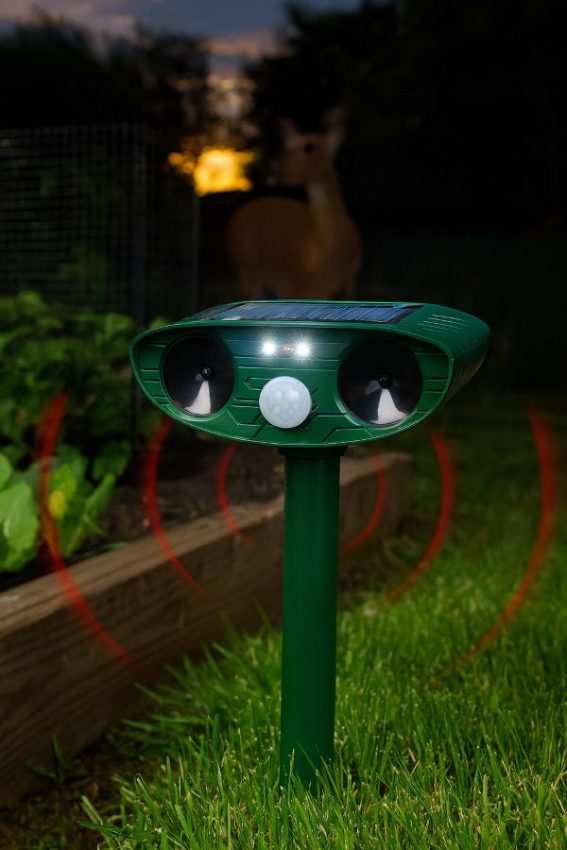
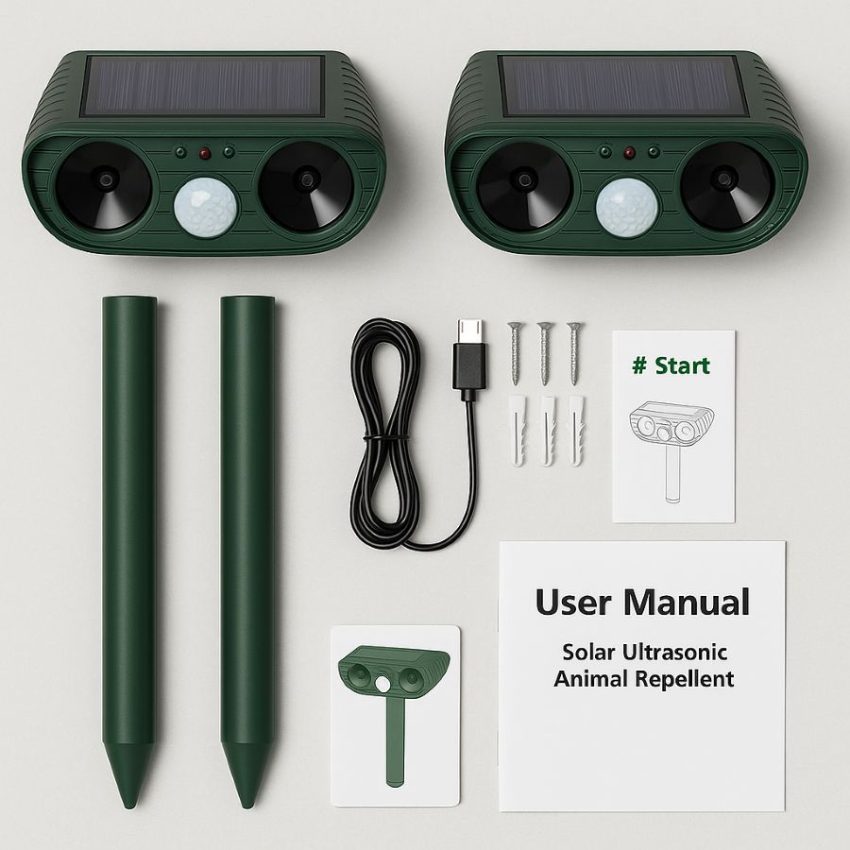
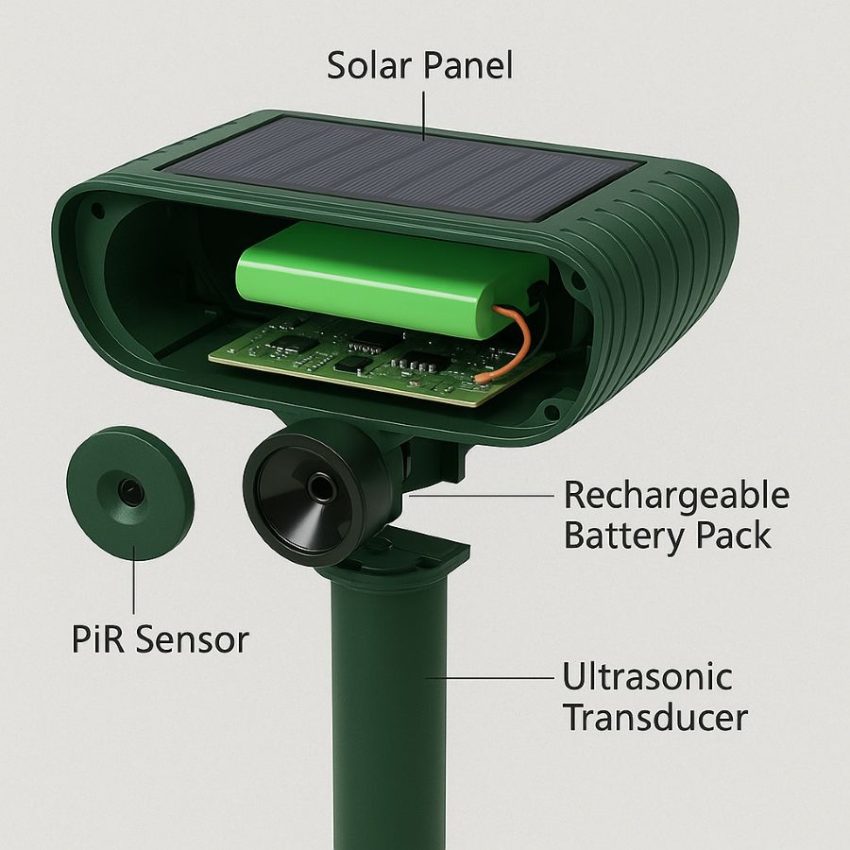
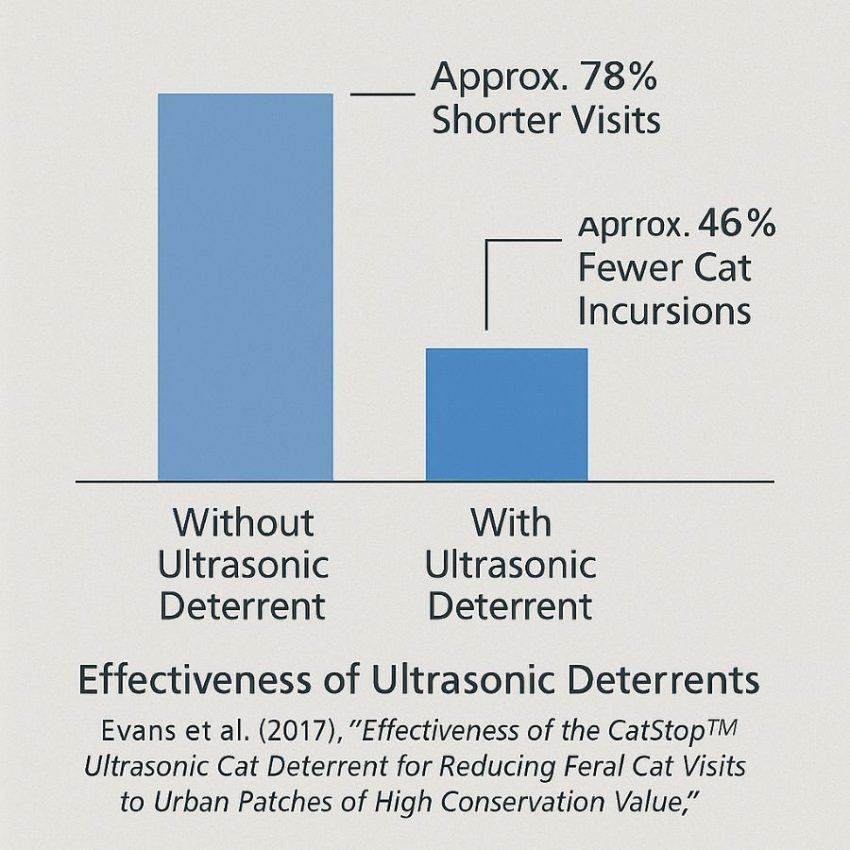

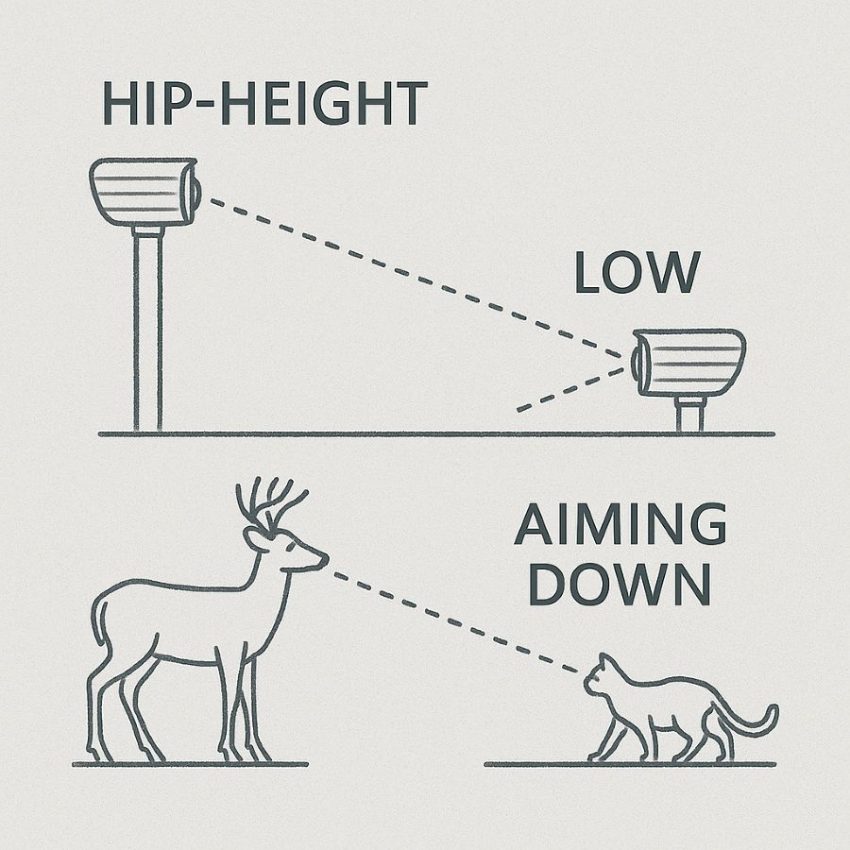
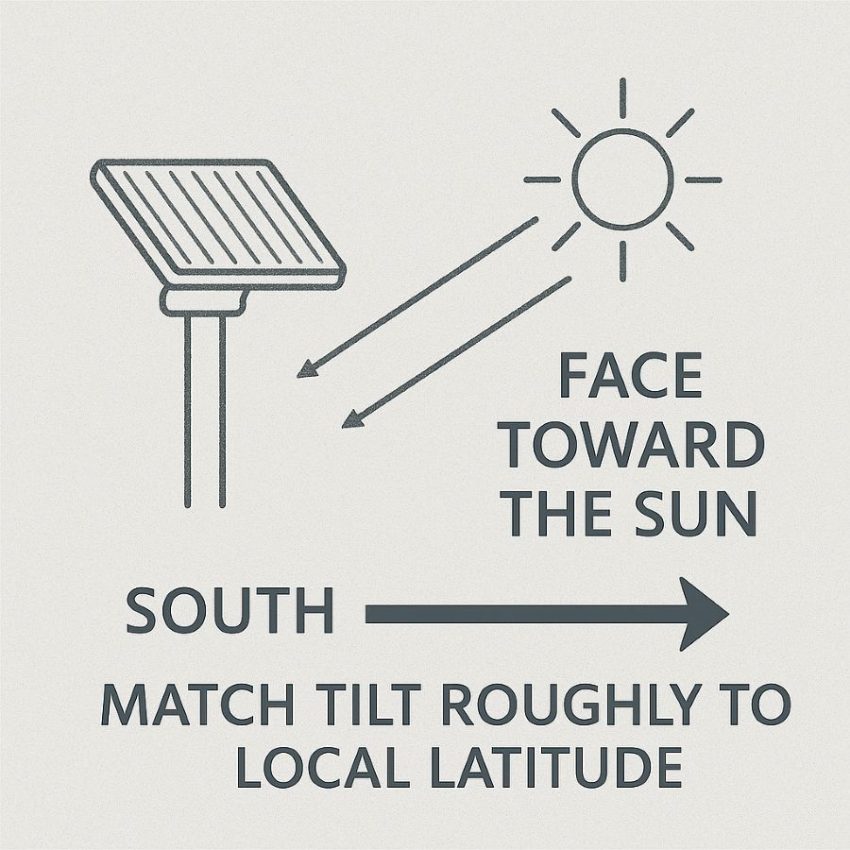
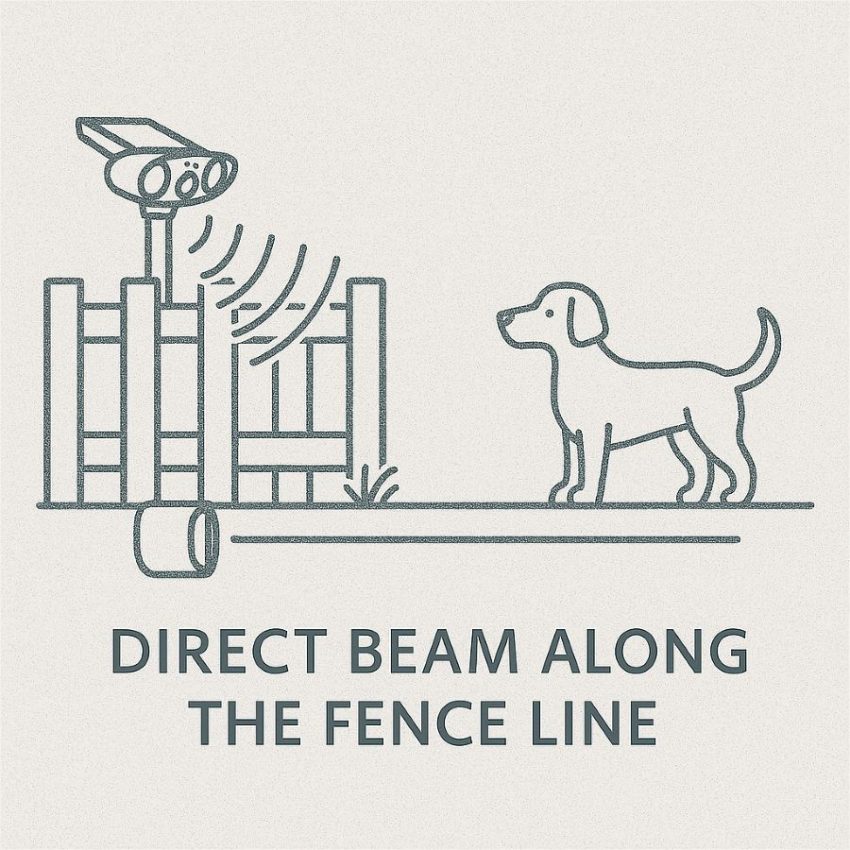
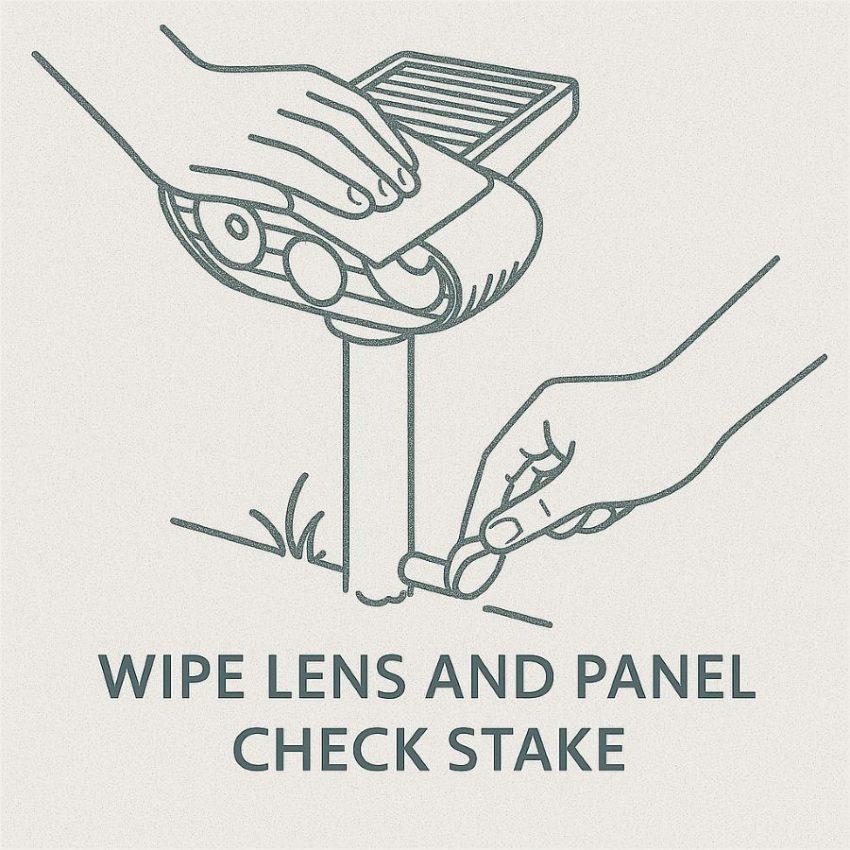

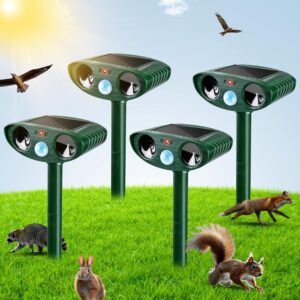
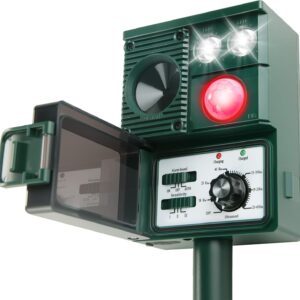
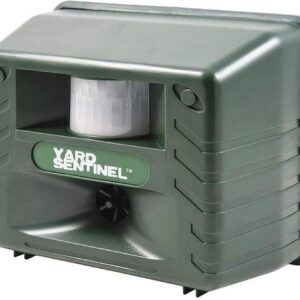
Reviews
There are no reviews yet.